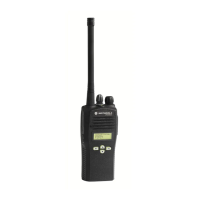2
English
INTRODUCTION
When an LTR trunked radio user wants to
communicate with another radio, the user’s
radio sends a “channel/talkgroup request” to
the home repeater. The system then sends
back a “channel/talkgroup grant” to the user’s
radio. The channel/talkgroup grant message
contains the number of a “go to” repeater to tell
the radio which repeater to use. This “go to”
repeater can be the same as the radio’s home
repeater or another repeater in the system.
The radio uses the “go to” repeater for
transmission. Once the transmission has
ended, this repeater is available for other
users.
CP200XLS RADIO FEATURES
Radio-Wide Features
• 128 Conventional Channels
• Up to 10 Sites and 100 Talkgroups
• Up to 20 Repeaters per Site
• 8-Character Alphanumeric Display
• 4 Programmable Feature Buttons
• 2 Memory Channels
• Telephone Interconnect
• User-programmable Phone (Full Keypad Model
only), Scan, and TPL/DPL Lists
• Busy Channel Lockout
• High/Low Power Settings
• Transmit Time-Out Timer
• Monitor and Sticky Permanent Monitor
• System Scan with 2 Priority Levels and Revert
Scan
LTR Trunked Features
• MDC 1200 Signaling
Conventional Signaling Features
• MDC 1200 Signaling
• Quik-Call II Signaling
• DTMF Signaling
- Selective Radio
Inhibit Decode
- Radio Check
Decode
-MDC Pre-Time
- PTT ID Encode/
Decode
-DOS
- Selective Radio
Inhibit Decode
- PTT ID Encode/
Decode
- Call Alert Encode/
Decode
- Selective Call
Encode/Decode
-Radio Call List
-Call Tone
Tagging
- DTMF PTT ID
Encode
-DTMF Call Alert
Encode
-DTMF
Selective Call
Encode

